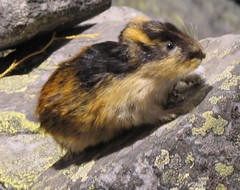Peregrine falcons are not Harry Potter fans.
If you live along the eastern seaboard of the United States, now is the time to look for snowy owls, Bubo scandiacus. These mostly-white owls, made famous by Harry Potter's faithful companion, Hedwig, are Arctic birds as one realises when they catch a glimpse of their thick insulative plumage -- even their feet and toes are protected with feathers. Despite this, lots of these birds are suddenly appearing in all sorts of strange places -- even in Bermuda and Hawaii!
Snowy owls are large and dramatic birds, standing two feet tall with a five-foot wingspan, making them very conspicuous. Adult males are pure white whilst the larger females retain some dark barring on their feathers. The juveniles and immatures have much heavier barring on their plumage. (Keen-eyed observers will notice that Hedwig was actually portrayed in the Harry Potter films by a number of individuals, both male and female.)
 Snowy owls primarily feed on lemmings, Lemmus lemmus, which are tundra-dwelling rodents (mounted lemming at left). An individual owl consumes as many as 1600 lemmings per year.
Snowy owls primarily feed on lemmings, Lemmus lemmus, which are tundra-dwelling rodents (mounted lemming at left). An individual owl consumes as many as 1600 lemmings per year.
Lemmings are small herbivorous rodents that breed rapidly, causing enormous population oscillations known as "boom" and "bust" years. Changes in lemming populations lead to population fluctuations in the predators that depend upon them as a primary food source -- particularly snowy owls. When lemming populations increase, snowy owls successfully raise more offspring each year -- and they can produce as many as seven owlets in a good breeding season. Even in the best of years, snowy owls tend to be nomadic, always searching out productive feeding areas, but when lemming populations crash, competition for prey becomes intense amongst the owls. This competition causes large numbers of snowy owls (mostly younger birds) to travel south in search of food. These vagrants prey on a wide variety of animals, including waterfowl, squirrels, rabbits, domestic pets and even fish. Such irregular and unpredictable movements are known as an "irruption".
When snowy owls roam widely, they meet other wildlife, which can lead to conflicts, as you see in this remarkable video of two different snowy owls that pop up a day apart on a New Jersey beach in close proximity to a pair of peregrine falcons. As you will see, the falcons were not very welcoming:
Video by Tom Johnson. You can see more of his work here: photography and videos.
GrrlScientist can also be found here: Maniraptora. She's very active on twitter @GrrlScientist and sometimes lurks on social media: facebook, G+, LinkedIn, Pinterest.
No comments:
Post a Comment